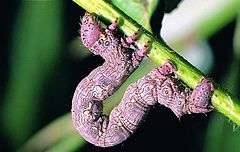Brindled beauty
| Lycia hirtaria Brindled beauty | |
|---|---|
 | |
| Male of Lycia hirtaria | |
| Scientific classification | |
| Kingdom: | Animalia |
| Phylum: | Arthropoda |
| Class: | Insecta |
| Order: | Lepidoptera |
| Family: | Geometridae |
| Genus: | Lycia |
| Species: | L. hirtaria |
| Binomial name | |
| Lycia hirtaria (Clerck, 1759 | |
The brindled beauty (Lycia hirtaria) is a Palearctic moth belonging to the family Geometridae.
Subspecies[1]
- Lycia hirtaria cataloniae Vojnits & Mészáros, 1973
- Lycia hirtaria diniensis (Oberthür, 1913)
- Lycia hirtaria hanoviensis (Heymons, 1891)
- Lycia hirtaria hirtaria (Clerck, 1760)
- Lycia hirtaria istriana (Galvagni, 1901)
- Lycia hirtaria pusztae Vojnits, 1971
- Lycia hirtaria uralaria (Krulikovsky, 1909)
Distribution
This species can be found in most of Europe, including Russia, Caucasus, Transcaucasia, Asia Minor, South Siberia, Yakutia, Russian Far East, Sakhalin and Japan. [2]
Habitat
These moths prefer woodland and suburban areas. [3]
Description

The brindled beauty has a wingspan of 4–5 cm. It is a large-bodied furry moth, which has a pattern which provides near-perfect camouflage on tree trunks and also gives the moth its name.The forewing ground colour is usually grey with black dusting.There is a curved anterior and a curved exterior cross line limiting the midfield. The Hindwings are also grey and have two or three crosslines. The females have a pale yellow suffusion on the wings and the front edges of their forewings are paler. [4] The males show large comb-like antennae. [5]
Variation female-ab. terroraria Krulik. is described as unicolorous grey, with weak traces of the lines on the veins of the forewing. Female -ab. fumaria Haw. is fuscous or smoky black, in extreme examples entirely unmarked.- diniensis Ob. differs little from the name-type, but the lines appear to be very strong and thick. Figured without description. Basses-Alpes.- ab. fasciata [Prout] is a beautiful modification of diniensis with the antemedian line double and with a blackish band extending from the median line of the forewing to the subterminal. Le Canadel. Var, France, - ab. flavescens [Prout] may be taken as the name of the more yellow-mixed form which is common in England, N. France, etc.- ab. congeneraria Hbn. has the antemedian and postmedian lines very distinctly double. Possibly forms a separate race in Algeria - istriana Galv. is a large, whitish-mixed form from Istria- hanoviensis Heymons is a small race, more densely scaled, the ground-colour more mixed with ochreous-yellow,the dark markings extended into strong suffusions. [6]
Biology

The brindled beauty is nocturnal. The moths fly from March to the end of May, and the males are attracted to light. [3][5]
The egg is ellipsoid, micropylar and somewhat concave and granulated; the rest of the surface somewhat glossy, the granulation discernible on strong magnification. [6]
The caterpillar of the brindled beauty ranges from greyish-green or brown in colour purplish, with thread-like longitudinal black lines and with yellow marks near the segment-incisionsand [4] [6]
The caterpillar is polyphagous, mainly feeding from late spring to early summer [5] on broad-leaved trees and deciduous shrubs (Betula, Quercus, Alnus, Fraxinus, Ulmus, Salix, Populus, Berberis, Ribes, Rosa, Rubus, Filipendula, Malus, Sorbus, Crataegus, Prunus, Tilia, Rhamnus, Vaccinium). [7] The pupa overwinters.
See also
| Wikimedia Commons has media related to Lycia hirtaria. |
External links
- European Butterflies and Moths by Christopher Jonko
- Lepiforum.de
References
- ↑ Biolib
- ↑ Fauna europaea
- 1 2 UK Moths
- 1 2 Carter, David. Butterflies and Moths, Dorling Kindersley, pg 200
- 1 2 3 The Butterflies and Moths of Northern Ireland
- 1 2 3 Prout, L.B. 1912–16. Geometridae. In A. Seitz (ed.) The Macrolepidoptera of the World. The Palaearctic Geometridae, 4. 479 pp. Alfred Kernen, Stuttgart.
- ↑ Paolo Mazzei, Daniel Morel, Raniero Panfili Moths and Butterflies of Europe and North Africa
- Carter, David - Butterflies and Moths (Dorling Kindersley Handbooks), Dorling Kindersley Ltd. London, 1992 ISBN 0-7513-2707-7.